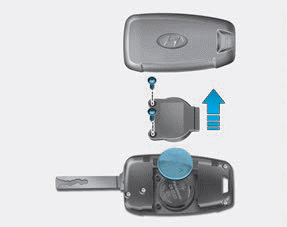Hyundai Palisade: Fuel Delivery System / Fuel Pump Control Module (FPCM)
Hyundai Palisade (LX2) 2020-2025 Service Manual / Engine Control/Fuel System / Fuel Delivery System / Fuel Pump Control Module (FPCM)
Description and operation
| Description |
The fuel pump control module (FPCM) is installed on the right side of the fuel
tank and controls the DC motor mounted inside the low pressure fuel pump. The
module compares instantaneous fuel pressure information measured by the fuel
pressure sensor (FPS) with target fuel pressure information provided by the
ECM and generates the desired target fuel pressure by controlling the fuel pump
motor and regulating fuel flow rate in the low pressure fuel line between the
low and high pressure fuel pumps.

| Operation |

| 1. |
The ECM provides target fuel pressure information to the FPCM via CAN
network.
|
| 2. |
The FPS provides the FPCM with actual pressure information of the low
pressure fuel line between the low and high pressure fuel pumps, and
the FPCM forwards the information to the ECM. Also, the FPCM diagnoses
faults in the FPCM, fuel pump motor and FPS and then provides the diagnosis
information to the ECM.
|
| 3. |
The FPCM compares the actual fuel pressure information measured by the
FPS with the target fuel pressure information provided by the ECM and
controls the voltage that is provided to the low pressure fuel pump
motor. The FPCM keeps regulating fuel flow rate by controlling the low
pressure fuel pump, depending on engine speed (rpm) and vehicle loads.
|
Specifications
| Specification |
|
Items |
Specification |
|
|
Applied Voltage (V) |
6 - 18 |
|
|
Current Consumption (A) |
Max. 15 |
|
|
Fuel Pressure |
Start |
Max. 600 KPa (Max. 6.1 kg/cm², Max. 87.0 psi) |
|
In operation |
350 - 500 KPa (3.5 - 5.1 kg/cm², 50.7 - 72.5 psi) |
|
Repair procedures
| Removal |
| 1. |
Release the residual pressure in fuel line.
(Refer to Fuel Delivery System - "Release Residual Pressure in Fuel
Line")
|
| 2. |
Remove the floor carpet service cover (A).
|
| 3. |
Remove the fuel pump service cover (A) after loosening the mounting
screws.
|
| 4. |
Disconnect the fuel pump control module connector (A) and fuel pressure
sensor connector (B).
|
| 5. |
Disconnect fuel feed tube quick-connector (C).
|
| 6. |
Remove the locking ring (A) by using the special service tool [No.:
09310-B8100].
|
| 7. |
Remove the fuel pump from the fuel tank.
|
| Installation |
| 1. |
Install in the reverse order of removal.
|
 Fuel Pump
Fuel Pump
Repair procedures
Inspection
1.
Turn ignition switch OFF and disconnect the negative (-)battery cable.
2...
 Fuel Pressure Sensor (FPS)
Fuel Pressure Sensor (FPS)
Description and operation
Description
The fuel pressure sensor (FPS) is installed on the top of the low pressure fuel
pump and measures the pressure in the low pressure fuel line...
Other information:
Hyundai Palisade (LX2) 2020-2025 Service Manual: Components and components location
..
Hyundai Palisade (LX2) 2020-2025 Service Manual: Special service tools
Special Service Tools Tool (Number and Name) Illustration Use 09581-11000 Piston expander Spreading the front disc brake piston. 09964-C1100 SCC Setting Reflector Used for front radar unit setting 0K964-J5100 Calibration Reflector Used for front radar unit setting 09964-C1200 SCC Setting Beam Used for front radar unit setting...
Categories
- Manuals Home
- 1st Generation Palisade Owners Manual
- 1st Generation Palisade Service Manual
- Fuse/Relay Panel Description
- How to reset the power liftgate
- Removing and Storing the Spare Tire
- New on site
- Most important about car
Battery replacement

If the remote key is not working properly, try replacing the battery with a new one.
Battery Type: CR2032
To replace the battery:
Copyright © 2025 www.hpalisadelx.com






